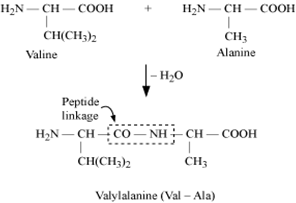 Short Answer Type
Short Answer TypeWhat is the cause of a feeling of depression in human beings? Name a drug which can be useful in treating this depression.
Explain the following behaviours:
(i) Alcohols are more soluble in water than the hydrocarbons of comparable molecular masses.
(ii) Ortho-nitro phenol is more acidic than ortho-methoxyphenol.
Explain the mechanism of acid catalysed hydration of an alkene to form corresponding alcohol.
Complete the following chemical reaction equations:
(i) C6H5N2Cl + H3PO2+ H2O --->
(ii) C6H5NH2+ Br2(aq.)--->
Describe the following giving the relevant chemical equation in each case:
(i) Carbylamines reaction
(ii) Hofmann’s bromamide reaction.
Answer the following question:
(i) What is meant by the chirality of a compound? Give an example.
(ii) Which one of the following compounds is more easily hydrolyzed by KOH and why?
CH3CHCICH2CH3 or CH3CH2CH2Cl
(iii) Which one undergoes S N 2 substitution reaction faster and why?![]()
Define the following as related to proteins:
(i) Peptide linkage
(ii) Primary structure
(iii) Denaturation
(i) Peptide linkage:
The amide formed between -COOH group of one molecule of an amino acid and –NH2 group of another molecule of the amino acid by the elimination of a water molecule is called a peptide linkage.
(ii) Primary structure:
The primary structure of a protein refers to the specific sequence in which various amino acids are present in it, i.e., the sequence of linkages between amino acids in a polypeptide chain. The sequence in which amino acids are arranged is different in each protein. A change in the sequence creates a different protein.
(iii) Denaturation:
In a biological system, a protein is found to have a unique 3-dimensional structure and a unique biological activity. In such a situation, the protein is called native protein. However, when the native protein is subjected to physical changes such as a change in temperature or chemical changes such as a change in pH, its H-bonds are disturbed. This disturbance unfolds the globules and uncoils the helix. As a result, the protein loses its biological activity. This loss of biological activity by the protein is called denaturation. During denaturation, the secondary and the tertiary structures of the protein get destroyed, but the primary structure remains unaltered.
One of the examples of denaturation of proteins is the coagulation of egg white when an egg is boiled.
Differentiate between thermoplastic and thermosetting polymers. Give one example of each.
 Long Answer Type
Long Answer Type(a) Draw the molecular structure of the following compounds.
(i) N2O5
(ii) XeOF4
(b) Explain the following observation:
(i) Sulphur has a greater tendency for catenation than oxygen.
(ii) ICI is more reactive than I2.
(iii) Despite the lower value of its electron gain enthalpy with a negative sign, fluorine (F2) is a stronger oxidizing agent than Cl2.
